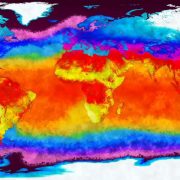As threats of a trade war between America and China are raging on and reportedly the newly appointed US admiral of the Asia Pacific just promised to contain China and to project power «when necessary»[1] the specter of a Cold War around China is beginning to materialize. Yet for America it is not a sudden change of heart. Present tensions have a long history, here we try to present it very briefly to help us to come to grips with them and also introduce angles by which these tensions could be still unraveled.
This historycan be divided in three waves, the three long phases of recent bilateral relations: one long, one very long, and one just short.
The very long wave
The very long wave begins with US Secretary of State Henry Kissinger’s visit to China, followed by that of President Richard Nixon in the early 1970s. Then there was a clear convergence of interests between Washington and Beijing. Washington wanted to make up for the imminent defeat in Vietnam. Beijing wanted to avoid being crushed between Soviet Union in the north and increasingly pro-Soviet Vietnam in the south.
This marriage of convenience became an almost official engagement in 1979, when China intervened against Vietnam in agreement with the United Statesand helped move weapons to the anti-Soviet mujahideen militants in Afghanistan. After the war, the US opened to exports of dual (civil and military) technologies to Beijing and integrated China into a larger commercial environment, boosting its exports and thus raising its foreign currency reserves. This, along with the Deng Xiaoping reforms launched in the same years, allowed China to move forward in the early stages of modernization and development.
There was therefore a Chinese internal plan for economic reform and opening up and an external plan of strategic realignment with the United States. This internal and external realignment was almost symbolically interpreted in the 1980s by Zhao Ziyang’s reforms,encouraged by the monetarists of the American Chicago school who were also inspiring Reagan’s liberal reforms.
This understanding was cracked but not broken between 1989 and 1992.
Various episodes contributed to the lacerations. There was the June 1989 Tiananmen crackdown; there was the fall of the Berlin Wall in November of the same year. There was the alt-communist attempted coup in the Soviet Union in August 1991 that toppled Soviet leader Mikhail Gorbachev and put an end to the USSR. Here, China even reached out to the Soviet conservatives.
All these episodes contributed one after another to the divergence in American and Chinese political sensibilities and priorities. But it was not the end.
At the beginning of the 1990s, US and China saw the start of commercial controversies that simply did not exist before. A sore point for the United States was the theft of intellectual property by the newly emerging Chinese companies.
This led to great indecision in the United States about what to do with China, until the beginning of negotiations for Beijing’s admission into the newly established WTO (World Trade Organization).
The plain consideration then was that the US was willing to give China time to change. China would then explode or become like America. It was a safe bet. Chances that China would successfully emerge in a third way were considered minimal.
In the meantime, America would help to turn China into a great manufacturing facility andthe base for the newly launched “globalization,” i.e. the process of delocalization of manufacturing to cheaper third countries, made possible by the overall security (there was no longer the threat of a sudden war, as during the Cold War) and logistics that had become much cheaper, thanks to technological innovations.
However, things started taking a different turn in 1999, with America bombing Serbia, China siding with Yugoslavia, and the US bombing of Beijing’s embassy in Belgrade. The whole episode in hindsight seems one of clashing naivetés between US and China. The Chinese publicfoolishly supported the Yugoslavian resistance against America, as if the world were back to the 1960s, oblivious to the huge complications of the drawn-out Yugoslavian war, and the US almost offhandedly dropped a bomb on the Chinese embassy.
Thread after thread, the US and China were moving apart. China backed South Korea’s Sunshine Policy with the North, but in 2001 the US made a U-turn and sandbagged it. Just months later, the crash landing of a US surveillance plane, the EP-3, on the Chinese island of Hainan on April 1 – almost an April Fool’s Day prank – heighted bilateral tensions even further.
The escalation of tension between US and China was interrupted with the September 11 al-Qaeda attack on New York. The US changed its priorities for some years, and thought that by democratizing and taking under its wing Afghanistan and Iraq, it could start a period of renewed power. Thanks to its foothold in these two countries, the US could control Central Asia, and thus all the routes of communication through the Eurasian continent and oil prices. Energy and logistics were to be rearranged.
Things didn’t work out – but why? In a nutshell, democracy is not easy to export. The US would have been better off picking one of Saddam’s generals and giving Iraq to him.
But in a few words, here is the root of a problem with Beijing. The US wanted China on its side against the USSR and for the sake as globalization; as long as results were coming in, it was willing to overlook the differences in the political system and the constraints and closures of its market. China also was gaining in the exchange. It got overall security and goodwill from America, both very important elements in the global economy, as well as access to markets and technology. And for these benefits, China was ready to overlook the constant and annoying Western pressure on human rights and on its political system.
As for who gained more, it is difficult to come up with a neat result, but overall China grew far more than the US, even taking into consideration the difference in their respective starting points.
The long wave
The failure of the war in Iraq, and the unproductive waste of hundreds of billions, contributed to the 2008 American financial crisis[2]. This brought to an end the period of pause in tensions between US and China. China deduced from the failures in Iraq and the financial crisis that the US was declining and could be brushed off – there was no need to try to become “American,” i.e. adopt the US political and economic model, because the model was flawed and should be rejected; the US came to different conclusions, especially after the December 2009 diplomatic disasters in Copenhagen.
In fact, then newly elected US president Barack Obama came almost hat in hand to Chinese president Hu Jintao in November 2009, offering a grand bargain: a massive collaboration onclean technology[3]. But the US also asked for an appreciation of the RMB, whose cheap exchange rate was harming all other exporting countries. The other countries, unlike China, had flexible exchange rates, and their rates were falling. China however refused to appreciate the RMB, thinking it was paying already more than its dues by financing US debt.
This plus the massive plan to finance internal investment helped global growth to eventuallyrecover and get out of the crisis. But the cheap RMB also hurt other economies twice: first because they were involved in the American crash, and second because the cheap Chinese exports (supported also by the massive credit expansion) slashed their share of global market.
China eventually came out ahead in the game, but it ruined its international prestige.
A decade earlier, during the 1997–98 Asian financial crisis, China stopped a wave of competitive devaluation, fuelled also by speculation on Wall Street, by refusing to depreciate the RMB. China was the hero of the day. Things in the region were so good for Beijing that Japan floated the idea of establishing an Asian Monetary Fund (AMF) to make up for the IMF, whose intervention in the crisis had made things worse. In fact, in the late 1990s, the US had raised the issue of freedom of navigation in the South China Sea, but in 1999 then premier Zhu Rongji was able to brush it off, offering some platitudes about the common development of the area[4].
A decade later, the Chinese failed to realize that when Obama was asking for the appreciation of the RMB, he was not just speaking for the US but for the rest of the world as well. When China then turned down the request, it showed that Beijing was simply seeking its own advantage, possibly as much as or more than the US. But even if for China’s neighbors the US and China were the same, between the old known devil and the new unknown devil, it was easy to choose the old one.
Still, for some countries in the region, China was certainly worse than the US. America didn’t humiliate it in a short border war, as China did with India; it didn’t have millennia of conflictswith Vietnam; it didn’t have unsettled war scores with Japan.
China simply didn’t see, or didn’t want to see, the complexity of the situation and moved to the environmental summit that December 2009 in Copenhagen as a sleepwalker. The meeting was a tactical disaster. The US wanted to meet the Chinese side, but the Chinese side didn’t arrange it, and then Obama almost stormed in and a Chinese minister yelled at him.
The point was that the US wanted China to cut its emissions, and it had promised in return it would cut its own. Obama had not managed to secure support for the cuts and wanted get something from Beijing to go back with leverage to Washington. Beijing didn’t want to cut emissions, which could dent its economic growth, and would do it only in return for specific US concessions.
Yet besides the Chinese blunders in handling the specificincident, there was a deeper lack of understanding. In Copenhagen the stakes were not about the exchange of cuts in emissions, but a true, bigger bilateral relationship between China and America. It was supposed to be the untold beginning of the big countries’ relationship. It turned out to be the beginning of a disaster.
From then on, things starting spiraling down. At the beginning of the year, Google voiced its strong concern about censorship and market access. Actually the internet giant had had concerns for months, but the US government kept them quiet in hopes of a possible grand agreement with China. Without it, the Google case got uncorked.
Then in 2010 came the controversy of South China Sea, where the US said it was part of it, as it concerned freedom of navigation, and Vietnam agreed with Washington, unlike ten years before when it sided with China. Frictions with Japan on the controversial claim of the SenkakuIslands also heated up, while cheaper Chinese industrial products were undercutting Japanese exports. The situation was so bad that Japan, turning its back on decades of resistance, finally backed the possibility of a free trade agreement with the US, opening to American agricultural exports.
Moreover, after the US failures in Afghanistan and Iraq, China launched its Belt and Road Initiative, but apparently the handling was inattentive. The US was offered a seat almost as a guest of China, and China imposed its conditions. It was not as part of something that China wanted to do with the US and everybody else. Also, China launched its great power diplomacy, which offered some kind of new Yalta, where Asia was to be given to China and the US would get everything else. But why should there be a division of the world? And would Asian countries be willing to be “given” to China? In fact, after the proposal was leaked, all of Asia was up in arms and in Washington lobbying against China and its division of the world.
The short wave
All of this boiled down to a widespread worldwide animosity against China around 2015. Why didn’t China see it coming? Two simple answers: Beijing was embroiled in its internal power struggles, and it didn’t understand that the world around itself was not the “all under heaven” of the imperial past, with China at the center and a negligible periphery making up only half of its population and wealth. It was a world dominated by the West and Western values and concepts, where China’s population and wealth was only a fraction of the total. Here alliances count as much as actual strength. Here China had no allies but only business partners.
But even among business partners, the strongest and most resilient foreign pro-China constituency, the mood had changed. Businessmen complained of not making money and of disruptive stealing of business secrets – not only of IPR. Common Western people were shocked at news of China’s theft of personal data, an infringement on their sacred privacy. They were also annoyed at the rough and uncouth attitude of Chinese business officials or even Chinese tourists, shouting and loitering all over.
This gave new fuel to the old activistworries about political oppression and lack of freedom in China. Politicians and strategists came to see this as all part of some grand design of China wanting to impose its rules on the world[5].
Of course some of the concerns have been addressed. Tourists have been told to behave themselves, and the massive stealing of personal data has been checked. China is also actively reaching out to Japan and India, understanding that bringing them on her side can help to improve the situation.
But the overarching issues are still present and getting stronger. There is no Soviet threat and no globalization drive to lead China and the world together. China doesn’t know the world, and the world is much bigger than China, although led by a country smaller than China population-wise, the US. Then for China to get things straight, it would need to unravel the three waves, which we summarily sketched here. It will not be easy.
In this, provocations coming from North Korea, which as we write are subsiding after months of tensions, or accidental clashes on the border, as occurred with India last summer in Doklam, could trigger broader explosions.
Will China want to unravel all of it? From Beijing, it feels that the world is unraveling faster. The EU could be on the verge of an explosion, torn apart by many contradictory pulls. The US of Trump looks like a circus unable to get the horses running around. The rest of the world is scattered. Perhaps if China closes down and waits, things will just fall it way… or will pile up until they bury it.
This leads one to believe that China has a plan for world dominance, as Pillsbury wrote[6]. Or as Graham Alison recently put it, “what we have known as ‘business as usual’ in relations with China is now forever in our rearview mirror. We have moved into new, uncharted terrain in which the dangers are greater than the opportunities.”[7]
[1] US Admiral outglines new military buildup to counter China.
[2] See my book China. In the name of law. A new global order, 2016, and the chapter “Thinking the Impossible: China’s World.”
[3] We immodestly believe to have also contributed to the idea of the grand bargain. See David P. Goldman and Francesco Sisci, “U.S.’s road to recovery runs through Beijing”, Asia Times, October 15, 2008.
[4] See also https://www.rsis.edu.sg/wp-content/uploads/rsis-pubs/WP01.pdf
[5] We published several articles on SettimanaNews that delve deeper into these issues.
[6] The Hundred-Year Marathon: China’s Secret Strategy to Replace America as the Global Superpower, 2016
[7] How Trump could stumble from a trade war into real war with China.






Very good.